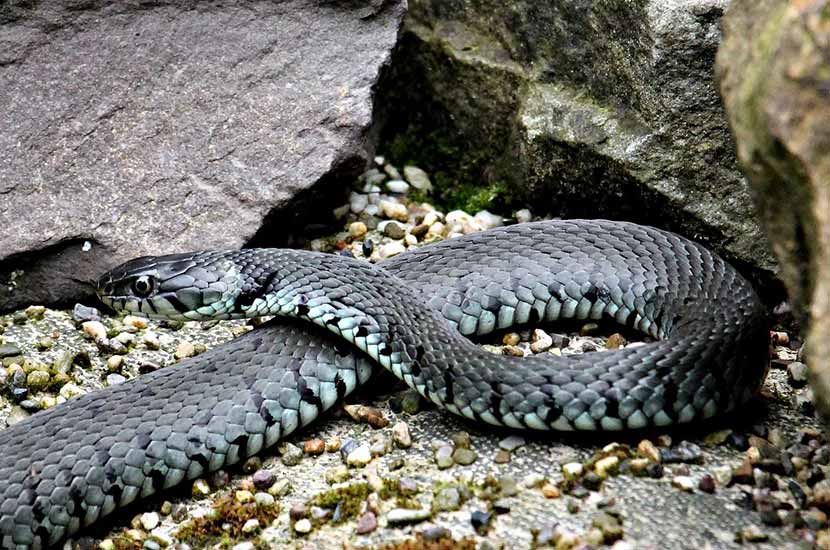Stephanie H Moy, DVM
As the pet industry has grown, snakes have become a popular pet. However, with the growth of their popularity there is an important illness that can have a startling affect on many snakes in the boa and python family. This illness is called Inclusion body disease (IBD). It is caused by arenavirus. However, there are great strides to find improvement in diagnosing and treating this disease.IBD was first identified as a disease in the United States in the 1970s. This disease is characterized by the formation of intracytoplasmic inclusions. In other words, there are abnormal protein materials within a normal cell. The virus itself was isolated in 2013.
The clinical signs generally seen primarily involve the central nervous system. The most common clinical signs are listed below.
- Torticollis (“wry neck”,”head-tilt): This can involve just the head or majority of the body. We have personally seen snakes with their upper half of the body turned 180°.
- Disequilibrium: The snakes do not seem to be steady. When handled, the movements can be erratic.
- Inability to right itself. Generally you will see a snake on its back and unable to right itself. This can be due to many factors. Since the nerves are affected it can be due to lack of proprioception (knowledge of knowing body position) or weakness (lack of nerve communication).
- Flaccid Paralysis: This is the generally weakness of muscles most likely due to the nerves not firing properly
- Regurgitation of food: This can happen after several days post eating.
- Secondary bacterial infection: Generally mouth and respiratory infections.
However, besides IBD, we have to take into consideration other disease processes that can cause these neurological signs.
- Nutrition: If an animal is not given the proper diet a lack of certain vitamins and minerals can cause neurological signs.
- Trauma: Any trauma to the head or spine.
- Gout: When the kidneys are not functioning properly, crystallization of uric acid can occur onto the nerves.
- Toxins: The improper use of pesticides (to kill mites), medications, and environmental agents (i.e.: wood shavings with high resin content).
- Parasites, bacterial, or viral infection of the nervous system.
At Chicago Exotics we recommend bloodwork and radiographs to be performed to see if there are other underlying disease processes. A qPCR for arenavirus can be run on swabs, tissues, and blood.
Bloodwork consist of a complete blood count (CBC) and biochemistry. A CBC informs us if there are any infections, inflammation, or anemia. Any changes to the CBC need to be addressed to allow the snake to improve. Biochemistry allows us to help evaluate the function of the organs. If the biochemistry indicates certain organs are not functionally well, it can help us determine if there are other disease processes affecting the snake. Radiographs help us evaluate the bone density as well as evaluate the spine.
At this time the best way to diagnose IBD is taking biopsies, or taking small pieces of tissues. These biopsies are considered a surgical procedure and the snake needs be under anesthesia. In most cases, a flexible endoscope with a biopsy device is used to biopsy the esophageal tonsils which are generally well developed in boid snakes. However, if the tonsils are not seen, then an incision is made over the liver to take some tissue. Through qPCR and special staining, we may see lymphoid cells or mucous epithelial cells with intracytoplasmic inclusions as well as get a confirmation of the virus’ presence. Unfortunately, if the testing is positive, there is no cure for IBD.
At this time the cause and the route of transmission are not known. Many of the snakes, but not all, identified with IBD have been also affected by a virus. IBD may represent a protein-storage diseased induced by a viral infection or mutation within the protein to act inappropriately. The route of transmission is not determined but it is suspected that direct contact is needed. Historically, when there has been an outbreak in snake colonies, the snake mites were present. It is possible the transmission occurs when mites bite one snake and then another snake. It is also possible IBD can be passed down from the mother to young.
The best way to reduce your risk of IBD is to buy from a well-established breeder. Ask questions about how the snake was hatched and the environment it was kept. A low price does not mean you will get a healthy pet.
Quarantining new snakes are important especially if several snakes are already in the house. The minimal quarantine time is 90 days. This long quarantine time is due to the slow metabolism of the snake and the length in which sickness can occur. Also, by quarantining, you can monitor the appetite, fecal output, and behavior of your new pet. You should have your snaked evaluated by your veterinarian at the beginning of the quarantine and ideally at the end of quarantine.
Here is a link to a great new publication on this virus:Identification, Characterization, and In Vitro Culture of Highly Divergent Arenaviruses from Boa Constrictors and Annulated Tree Boas: Candidate Etiological Agents for Snake Inclusion Body Disease
Mark D. Stenglein, Chris Sanders, Amy L. Kistler, J. Graham Ruby, Jessica Y. Franco, Drury R. Reavill, Freeland Dunker, and Joseph L. DeRisiReferences
- Reptile Medicine and Surgery, 2nd edition. Mader, Douglas R.
- Inclusion Body Disease, A Worldwide Infectious Disease of Boid Snakes: A review. Chang, Li-Wen BVM and Jacobson, Elliott R. DVM, PhD, Dip. ACZM
An educational handout concerning reptiles and Salmonella is available through the Association of Reptilian and Amphibian Veterinarians. Please ask your veterinarian for a copy.
If you have any questions, please feel free to call us at (502) 241-4117.

